 On the eve of Benedict's pastoral
On the eve of Benedict's pastoral
visit to Viterbo and Bagnoregio
Translated from
the Italian service of

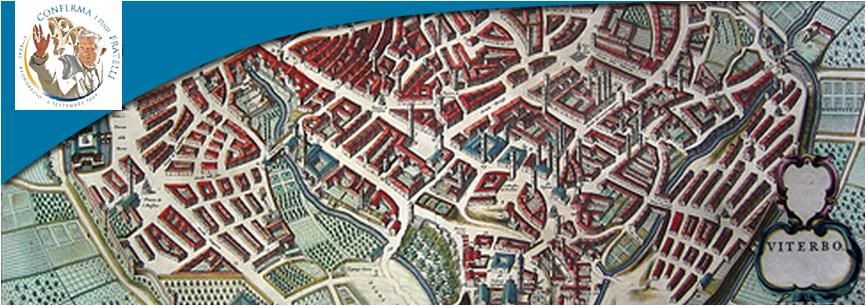
The city and the diocese of Viterbo are all set to welcome Benedict XVI who arrives at that ancient capital tomorrow at 9 a.m. by helicopter.
He will celebrate Mass in Viterbo, and in the afternoon, he will pay a visit to Bagnoregio to venerate a relic of that town's most outstanding son, St. Bonaventure, Doctor of the Church.
Antonella Palermo reports from Viterbo:
In the past few days, the city of Viterbo has been carrying out a technical and logistical dress rehearsal, in effect, for the Pope's visit.
Along the narrow streets of the historical center - which still have traces of the Feast of Santa Rosa marked by the Viterbesi with great pomp and circumstance on Sept. 3-4 - the yellow-and-white flags of the Vatican adorn all the building that have artistic and religious significance.
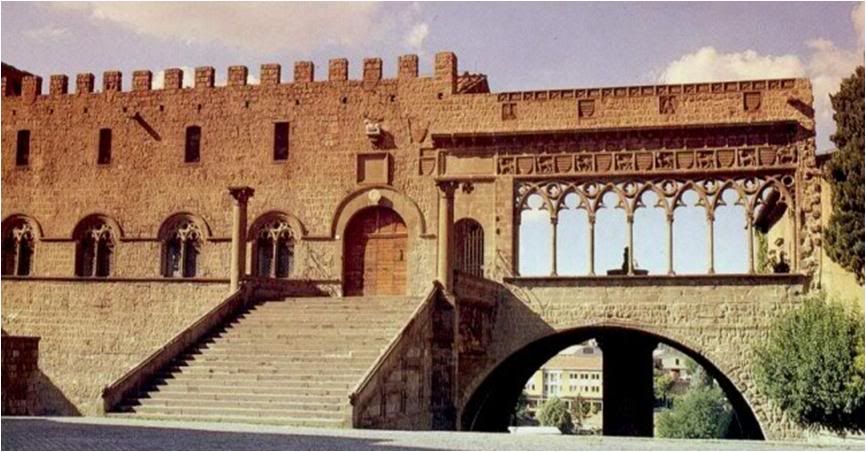
This is after all the City of Popes, famous for the first Conclave in history, when in 1271, after 33 months of a
sede vacante, Blessed Gregory X was final elected Pope when the townspeople placed the indecisive cardinals under lock and key to force them to decide. Five other Popes were elected in Viterbo, of whom four are buried here.
A pleasant September sun highlights the new bronze doors of the Cathedral of San Lorenzo which the Holy Father will bless tomorrow. A project of Mons. Lorenzo Chiarinelli, Bishop of Viterbo, the two lateral doors which complement the central door installed in 2004 were completed in time for the visit. The triptych is shown below:

Where the central door is dedicated to the Luminous Mysteries, with the 127a Conclave and the city's patron saints, Rosa and Lorenzo, as additional motifs, the two laterals depict the 1986 unification of five ancient dioceses and a historic Benedictine abbey into the single Diocese of Viterbo.
In Valle Faul, where the Holy Father will concelebrate Holy Mass at 10:30, they were putting the finishing touches to the two-level altar stage which is designed to look like an open shell.
Some 200 diocesan priests and religious representing more than 90 parishes of the diocese will be concelebrating.
There is also great anticipation at the Shrine of the Madonna della Quercia and in Bagnoregio.
"He is the first Pope ever to visit here and we are very very happy," said the mayor of this little town which gave birth to St. Bonaventure, whose arm is kept in the Co-Cathedral of San Nicolas in Bagnoregio {he is buried in Lyons, where he died).
Benedict XVI will be venerating here a spiritual and intellectual mentor who had a significant role in his theological formation.
We asked Mons. Chiarinelli what he expects of the visit.
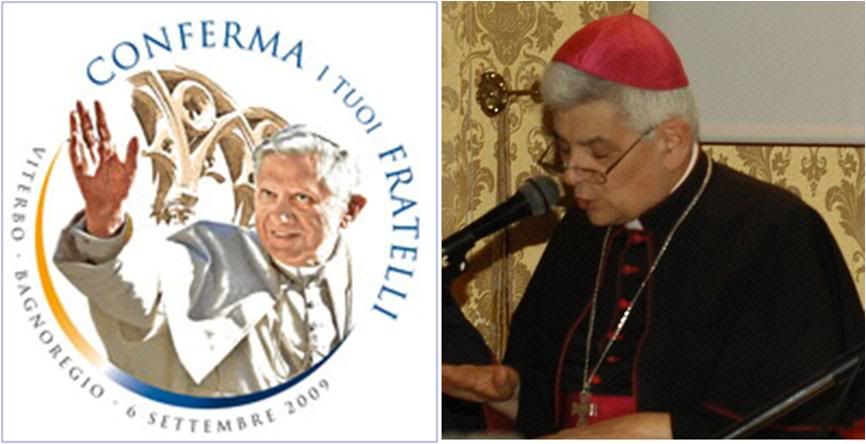
MONS. CHIARINELLI: Basically, it is expressed by the motto on our logo for the visit, using the words of Jesus to Peter: "Confirm your brothers" int he faith.
We need to recover an active awareness to realize the joy and the hope in living our faith in today's world - for the young people in particular, but really for the entire territory, for this Church.
How has Viterbo prepared for this visit?
In a very beautiful way. As a bishop, I am not just surprised but in admiration - for the joy, the enthusiasm, among the people and even among all the institutions during the preparation for the visit, a unanimity and synergy which are truly admirable.
Viterbo was the papal seat during a historical era that was distinguished by the severe conflicts between the Guelphs [pro-Pope elements] and the Ghibellines [pro-Emperor]. Today, the Church itself has internal conflicts...
I believe there are two expressions that we must take from the Second Vatican Council: the Church as a sign of communion in society and in history, and the concept of communion itself.
Pope Benedict XVI has always insisted on this weight-bearing idea from the Council, because the Church is a brotherhood. As the Council said, the Church is 'imago Trinitatis' - the image of the Trinity, which is a relationship - and so we must recover these relationships among ourselves.
And the Council urges us to construct the new reality of authentic communion, in which we see everyone else as just like ourselves,
What is the importance of the Pope's visit to Bagnoregio?
Because besides the experience of popular faith that we have been experiencing these days, as in the feast of Santa Rosa, there is also 'docta fides', informed faith.
Faith is a challenge to intelligence, Benedict XVI has pointed out, but faith is a friend of intelligence, to which intelligence must open it=s horizons.
This opening to transcendence in Bonaventurian thought and in the meditation Joseph Ratzinger devoted to St. Bonaventure's theology of history is a provocation to contemporary secular culture but it also constitutes a powerful appeal.
 THE MADONNA DELLA QUERCIA
Translated from
THE MADONNA DELLA QUERCIA
Translated from
the Italian service of


 The Basilica of the Madonna and its adjoining monastery complex, now converted into a multi-purpose social center. Below, the miraculous image venerated in the Basilica:
The Basilica of the Madonna and its adjoining monastery complex, now converted into a multi-purpose social center. Below, the miraculous image venerated in the Basilica:
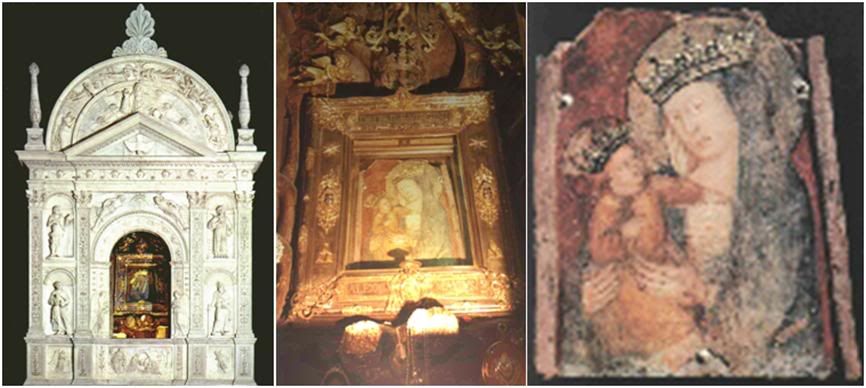
Co-patron of the Diocese of Viterbo, along with Santa Rosa and San Lorenzo, is the Madonna della Quercia (Our Lady of the Oak) who is venerated in the shrine where Benedict XVI will have lunch and rest after the Mass in Viterbo.
The Domus Quercia, as the monastery complex of the Shrine is now known.
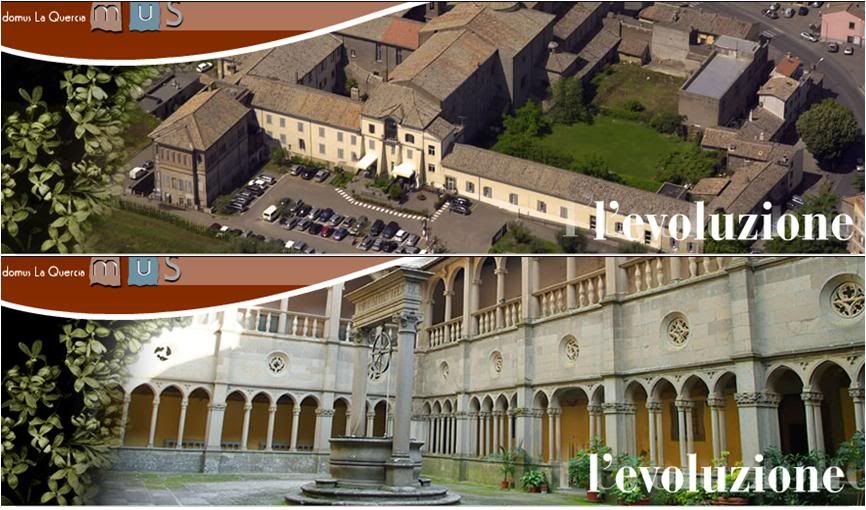
He will also pray here with some 120 cloistered nuns from the various monasteries of the diocese, before proceeding to Bagnoregio. Antonella Palermo rerports further:
Wherever faith has prevailed, the grace of the Lord has been abundant. Thsi is the story of the Shrine of the Madonna della Quercia, located two kilometers from the center of Viterbo which will host Benedict XVI for a few hours Sunday.
Here, in the 15th century, extraordinary things happened that the Viterbesi immediately saw as a sign of divine intervention, which among other things, saved the city from the plague in 1467 as it would be saved later from bombings in World War II.
It all began with an image of Our Lady and the Infant Jesus that a peasant had painted on a tile which he attached to an oak tree on his property at a spot where highwaymen used to ambush passersby. This was around 1417.
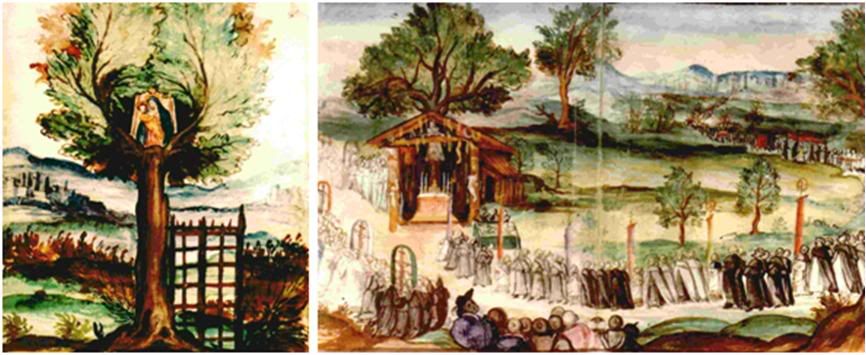
Over the years, the local people came to pray at the oak, and a series of miraculous events connected with the image caused devotion to grow. [Initially, the fact that individuals who attempted to take the image home found that the image always 'returned' miraculously to the oak.]
By the time of the Great Plague of 1467, its fame was such that the faithful came in the thousands (it is recorded that as many as 30,000 came on a single day) to ask to be spared from the affliction.
Since the 16th century, there has been a Basilica on the site of that oak, and the tile painting is venwerated at the central altar. When John Paul II visited Viterbo in 1984, he crowned the image with his own rosary.
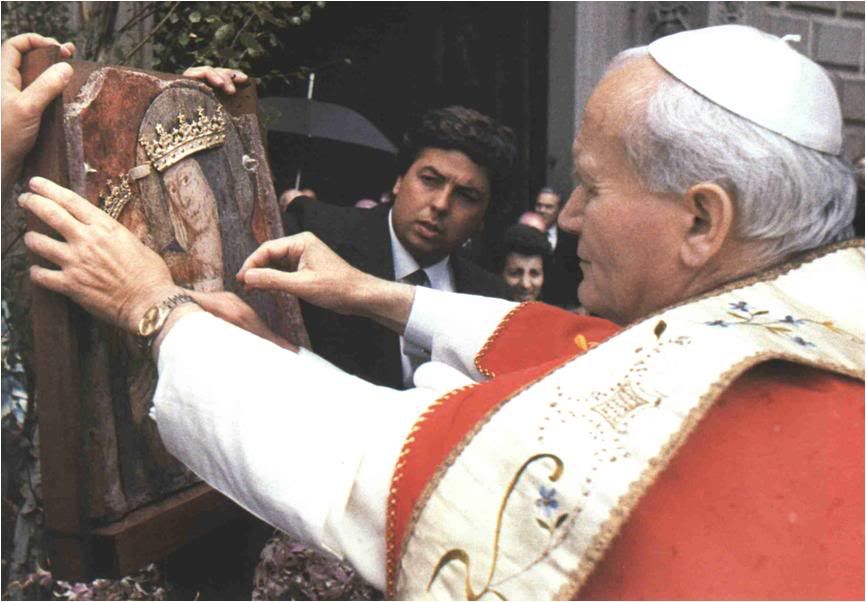
Says Rector Angelo Massi: "It is the most beautiful memory we habe. Speaking at the Shrine, he told our people, 'I have left my rosary to your Madonna. May it be the reminder of the prayer that should always surround Our most Blessed Lady, for peace, for teh world, for the young people, for everyone'."
Meanwhile, on the other saint that Benedict XVI will be venerating on his sixteenth pastoral visit in Italy, we spoke to Mons. Dante Bernini, emeritus Bishop of Albano Laziale, about the importance of St. Bonaventure in the history of the Church. The saint was Bishop of Albano for two years:
"Bonaventure gave Franciscanism, which was born in the heart of Francis of Assisi at the inspiration of the Holy Spirit, something that Francis in his evangelical authenticity did not forget but did not bring to light enough - which is the relationship between faith and reason, with faith as the starting point (for Francis the definitive and inescapable element), and using reason always with that pre-eminent quality of charity which Francis had in his heart and transmitted to his religious family. Bonaventure brought all this together in a way that was deeper, so to speak, and more incisive for the life of the Church."
[Modificato da TERESA BENEDETTA 06/09/2009 12:08]